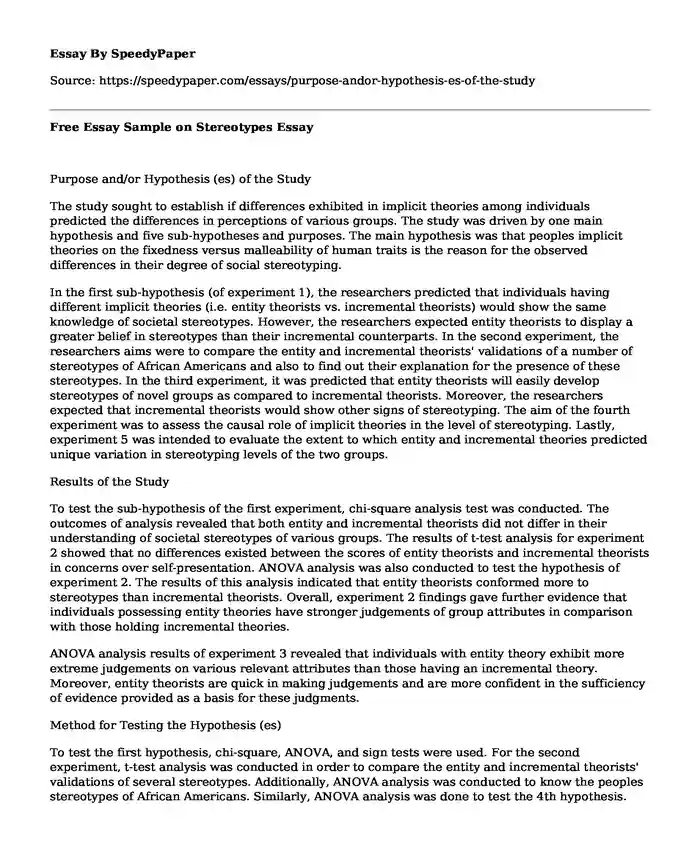
| Type of paper: | Essay |
| Categories: | Stereotypes |
| Pages: | 2 |
| Wordcount: | 540 words |
Purpose and/or Hypothesis (es) of the Study
The study sought to establish if differences exhibited in implicit theories among individuals predicted the differences in perceptions of various groups. The study was driven by one main hypothesis and five sub-hypotheses and purposes. The main hypothesis was that peoples implicit theories on the fixedness versus malleability of human traits is the reason for the observed differences in their degree of social stereotyping.
In the first sub-hypothesis (of experiment 1), the researchers predicted that individuals having different implicit theories (i.e. entity theorists vs. incremental theorists) would show the same knowledge of societal stereotypes. However, the researchers expected entity theorists to display a greater belief in stereotypes than their incremental counterparts. In the second experiment, the researchers aims were to compare the entity and incremental theorists' validations of a number of stereotypes of African Americans and also to find out their explanation for the presence of these stereotypes. In the third experiment, it was predicted that entity theorists will easily develop stereotypes of novel groups as compared to incremental theorists. Moreover, the researchers expected that incremental theorists would show other signs of stereotyping. The aim of the fourth experiment was to assess the causal role of implicit theories in the level of stereotyping. Lastly, experiment 5 was intended to evaluate the extent to which entity and incremental theories predicted unique variation in stereotyping levels of the two groups.
Results of the Study
To test the sub-hypothesis of the first experiment, chi-square analysis test was conducted. The outcomes of analysis revealed that both entity and incremental theorists did not differ in their understanding of societal stereotypes of various groups. The results of t-test analysis for experiment 2 showed that no differences existed between the scores of entity theorists and incremental theorists in concerns over self-presentation. ANOVA analysis was also conducted to test the hypothesis of experiment 2. The results of this analysis indicated that entity theorists conformed more to stereotypes than incremental theorists. Overall, experiment 2 findings gave further evidence that individuals possessing entity theories have stronger judgements of group attributes in comparison with those holding incremental theories.
ANOVA analysis results of experiment 3 revealed that individuals with entity theory exhibit more extreme judgements on various relevant attributes than those having an incremental theory. Moreover, entity theorists are quick in making judgements and are more confident in the sufficiency of evidence provided as a basis for these judgments.
Method for Testing the Hypothesis (es)
To test the first hypothesis, chi-square, ANOVA, and sign tests were used. For the second experiment, t-test analysis was conducted in order to compare the entity and incremental theorists' validations of several stereotypes. Additionally, ANOVA analysis was conducted to know the peoples stereotypes of African Americans. Similarly, ANOVA analysis was done to test the 4th hypothesis. Lastly, ANOVA and regression analysis were conducted to test the 5th hypothesis (Levy, Stroessner, & Dweck, 1998).
Implications for the Results
Implicit theories has an effect on organization and structuring of information in memory.
On way of reducing stereotyping is by changing peoples belief about the nature and origin of their traits.
References
Levy, S. R., Stroessner, S. J., & Dweck, C. S. (1998). Stereotype formation and endorsement: The role of implicit theories. Journal of Personality and Social Psychology, 74(6), 1421.
Cite this page
Free Essay Sample on Stereotypes. (2019, Aug 30). Retrieved from https://speedypaper.net/essays/purpose-andor-hypothesis-es-of-the-study
Request Removal
If you are the original author of this essay and no longer wish to have it published on the SpeedyPaper website, please click below to request its removal:
- Comparison Essay Example: the Books The War of the Worlds and World War Z
- Free Essay with a Project Summary on Nurses' Productivity
- Free Essay about NAB Company: Operation, Technology, and Management Plan
- Explanations of How Love Crosses Class Lines - Free Paper with the Article Analysis
- Sustainability and Leadership, Business Essay Example
- Essay Example on Service Encounters
- Free Essay: Organizational Development, Workforce Planning, and Succession Planning
Popular categories




